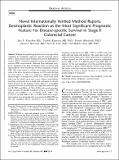Novel internationally verified method reports desmoplastic reaction as the most significant prognostic feature for disease-specific survival in stage II colorectal cancer
Abstract
Multiple histopathologic features have been reported as candidates for predicting aggressive stage II colorectal cancer (CRC). These include tumor budding (TB), poorly differentiated clusters (PDC), Crohn-like lymphoid reaction and desmoplastic reaction (DR) categorization. Although their individual prognostic significance has been established, their association with disease-specific survival (DSS) has not been compared in stage II CRC. This study aimed to evaluate and compare the prognostic value of the above features in a Japanese (n=283) and a Scottish (n=163) cohort, as well as to compare 2 different reporting methodologies: analyzing each feature from across every tissue slide from the whole tumor and a more efficient methodology reporting each feature from a single slide containing the deepest tumor invasion. In the Japanese cohort, there was an excellent agreement between the multi-slide and single-slide methodologies for TB, PDC, and DR (κ=0.798 to 0.898) and a good agreement when assessing Crohn-like lymphoid reaction (κ=0.616). TB (hazard ratio [HR]=1.773; P=0.016), PDC (HR=1.706; P=0.028), and DR (HR=2.982; P<0.001) based on the single-slide method were all significantly associated with DSS. DR was the only candidate feature reported to be a significant independent prognostic factor (HR=2.982; P<0.001) with both multi-slide and single-slide methods. The single-slide result was verified in the Scottish cohort, where multivariate Cox regression analysis reported that DR was the only significant independent feature (HR=1.778; P=0.002) associated with DSS. DR was shown to be the most significant of all the analyzed histopathologic features to predict disease-specific death in stage II CRC. We further show that analyzing the features from a single-slide containing the tumor’s deepest invasion is an efficient and quicker method of evaluation.
Citation
Nearchou , I P , Kajiwara , Y , Mochizuki , S , Harrison , D J , Caie , P D & Ueno , H 2019 , ' Novel internationally verified method reports desmoplastic reaction as the most significant prognostic feature for disease-specific survival in stage II colorectal cancer ' , American Journal of Surgical Pathology , vol. 43 , no. 9 , pp. 1239-1248 . https://doi.org/10.1097/PAS.0000000000001304
Publication
American Journal of Surgical Pathology
Status
Peer reviewed
ISSN
0147-5185Type
Journal article
Description
Funding: Medical Research Scotland and the Japan Society for the Promotion of Science.Collections
Items in the St Andrews Research Repository are protected by copyright, with all rights reserved, unless otherwise indicated.

